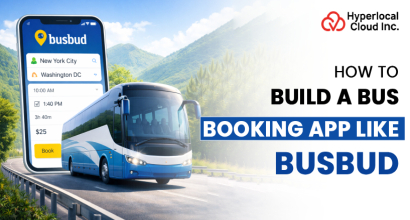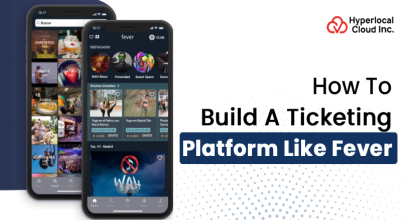The United States is home to the second-biggest online food delivery market, boasting an estimated revenue of $218 billion in 2022. The forecast depicts that 2027 will grow even further, edging close to the 500-billion mark as meal delivery and online grocery segments continuously grow in the US.
With ample food delivery apps available today, one name that a major chunk of the world reiterates is Grubhub. It is one of America's most-used food delivery platforms. The app generated a revenue of $2.4 billion in 2022, which increased by 5% from last year.
Developing a food delivery app like Grubhub is a cakewalk nowadays. However, generating the same profits as the app needs effective strategies and a guide on how it makes money.
This blog post explores how Grubhub makes money and helps restaurants fuel their marketing goals.
Understanding the Grubhub Business Model
Founded in 2004, Grubhub is a prominent food delivery platform that connects local restaurants with their target customers. The app uses over 60 technologies and has a cohesive UX and UI design. It has risen to be the key changemaker in the industry.
Grubhub is based on a business model that provides an online marketplace for restaurants to register on the platform and let their customers place orders and receive delivery at their doorsteps.
Below is how-
For Restaurants
- They get access to the proven ordering Grubhub platform.
- The app provides complete access to customer preferences and analytics.
- Customers find restaurants, including those that have only heard a little before.
- They can emphasize cooking great food, while Grubhub accounts for delivery.
- Online ordering caters to more customers over phone calls.
For Customers
- They get ample food choices by sitting on a couch.
- Finding a restaurant is easy and fast.
- Users can save their favorite orders and payment details.
- Customers can track the delivery of their ordered foods.
Thinking of Launching Your Own Delivery App?.
Revenue Insights: How Does Grubhub Make Money?
Grubhub is a logistics company that owns no restaurant. Ergo, there are no operational expenses as brick-and-mortar restaurants have. Still, it serves a lot of food to people daily.
Grubhub has an effective and straight forward revenue strategy. It has two primary income streams: restaurants and customers. Have a look-
From Restaurants-
- Commission Fee: The app has partnered with more than 310,000 restaurants. Thus, the company charges a commission to each partner restaurant for every order delivered on the platform. The commission fee fluctuates from 5% to 15%. Mostly, it averages around 13.5% for an order.
- Running Ads: Grubhub has interesting marketing and promotional programs for restaurants, where it places specific restaurants at the top for a certain period. Also, the listing relies on the commission structure. For instance, a restaurant owner can feature their business on top of the listing by paying more for orders placed on the platform.
- Order Volume Incentives: Grubhub encourages restaurants that have yet to join the platform by offering discounts and bonuses based on their stock and the volume of orders they receive. Further, the app earns through delivery charges, commission fees, and more relevant elements.
From Customers
- Delivery Fee: Grubhub charges delivery fees to consumers. A delivery fee for nonsubscribers is around $2.49. Also, the service fee is 10% of the order value, and the small order fee is $2 for orders under $10. These fees contribute to earnings while encouraging customers to enhance their order values.
- Subscription Programs: The subscription programs are enticing, such as Grubhub+. It provides customers with benefits, such as unlimited free delivery for orders over $12 or discounts for a monthly fee of $9.99. These subscription fees bring the platform's recurring revenue stream.
- Gift Cards: Though every restaurant offers such deals individually, Grubhub offers gift cards that customers find reasonable while purchasing food for their loved ones, friends, or peers. A sale of gift cards generates revenue with options ranging from solo gift cards (starting from $30, $60, or custom) to bulk gift cards (minimum of $2100).
- First Order: Food delivery apps have compelling deals for first-time users. They often provide big discounts to them, so they make their first order. Grubhub does the same to engage more customers to join and use the portal. It makes the platform to gain more customers and earn more when they place an order even after making their first order.
Irrefutably, Grubhub has delectable ways to serve different customers. So, what marketing strategies does it use? Let’s discuss!
Restaurant Marketing Simplified: How Does Grubhub Make it Possible?
Grubhub is winning the food industry market. When restaurants join, they gain instant access to 33+ million potential customers. The app is a miracle to brand awareness and revenue growth due to the following marketing tools that restaurants love to avail of.
- Promotions and Loyalty: Restaurants promote their brands on the app or website or share personalized emails with loyal customers. The app offers them excellent features and tools to boost sales without hindering their pockets.
- Free Professional Photoshoot: The platform allows restaurants and cafes to use a menu photoshoot feature for free. It is an outstanding way to exhibit their foods with delicious photos of their delightful menu items.
- Reviews and Ratings: It is the perfect way for restaurants to know about their customers and respond to them directly on their reviews. Also, this tool helps restaurants know about their areas of improvement.
Now, you can launch your branded food delivery app with the same tools and features as Grubhub by contacting professional developers for apps and websites.
When any restaurant joins your platform, the chances of increasing sales and reach will be high.
For instance, Salt Lake City's Pearl Express witnessed a 195% increase in sales within six months of using Grubhub Direct. The platform connected the restaurant to new customers, giving orders on its website and through Google Business listing. It affected Grubhub's revenue, too.
Different Types of Food Delivery Business Models
Two major food delivery business models dominate online food ordering and delivery. They are-
- Aggregator Business Model
- Inventory Model
Aggregator Business Model
Based on this model, online food businesses (like food delivery apps) are intermediate between restaurants and customers. They allow multiple restaurants to register and function on a single platform. The business model aggregates various restaurants' services and amalgamates them into a single portal.
Uber Eats, Delivery Hero, and Just Eat are a few big names in the food delivery sector that have adopted the aggregator business model. Undeniably, their growth is exponential.
To launch a food delivery platform with features of such big names, you must consult professional food delivery app developers to customize it per your needs.
The aggregator business model is further classified into two models based on the delivery operations.
- The Order and Delivery Model
Three major entities involved in this business model are the Admin or platform owner, delivery service provider, and merchants or restaurant owners. The third party takes care of the food delivery in this business model. The delivery service provider sets the delivery charges on orders and includes a courier or logistics company that unites with the platform owner to deliver food to consumers.
If you don’t want to invest in employing a delivery fleet, this app is helpful. The admins or app owners associate with a courier service and assign food delivery-related operations to it. The portal owner doesn’t need to worry about managing deliveries as third-party logistics services handle all orders.
- Integrated Model
In this business model, restaurants and admins manage deliveries. Many restaurants have a pool of delivery agents and look for platforms to bring their offerings online. Building a platform using an integrated model is a great way to cater to such restaurants.
This business model creates a way for various outlets to be on the platform that, in turn, enhances numerous choices for customers regarding restaurants and dishes. It allows restaurants with or without delivery fleets to stay in the food delivery marketplace and operate efficiently.
Inventory Model
This model allows online food delivery businesses to do everything in-house. Only one entity performs the work, from launching the food delivery app or website to preparing orders and delivering food to customers' doorsteps. The app/platform owner controls the complete value chain.
Food businesses with multiple restaurant chains, such as Burger King, Domino's, and McDonald's, adopt this model. Those owning a chain of restaurants want to build a similar platform like Grubhub based on such a model. In that case, you can contact professional food delivery websites and app developers to get it.
Want to start your own food delivery platform?
Wrapping Up!
The business model of Grubhub has played a significant role in establishing it in the market. It is essential first to understand the model based on which a particular platform is built before replicating the same platform for your business. Consider a few factors, such as alignment with your business goals, convenience delivered to customers, and scope of technological advancements. It helps you decide on features you need to invest in.
As technology disrupts the online food delivery business, developing an app like Grubhub needs developers dedicated to providing solutions for business needs. Further, you can opt for white-label solutions to save time and customize accordingly.



